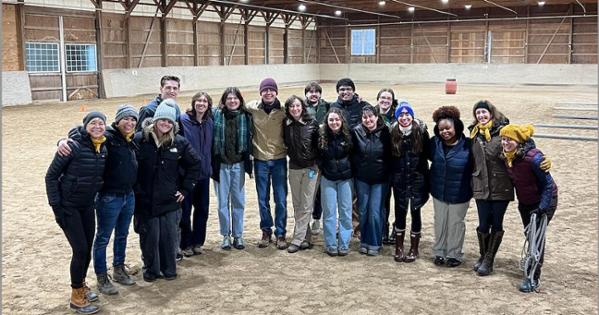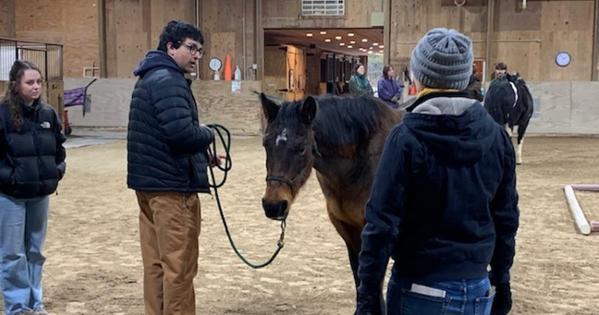Leaders Learn How to Put Their Best Hoof Forward

This semester, students in School of Public Affairs adjunct professor Angela Chiarenza’s class are exploring what it means to be a leader.
On February 8, more than a dozen American University students participated in a three-hour, equine-partnered leadership development program led by School of Public Affairs professor Chiarenza and her team. As an offering connected to their Leadership Studies Capstone course—which is largely focused proposing creative solutions to a current challenge—students who engaged in this experiential learning opportunity were challenged to put theory into practice.
“Honestly, this is one of the most interesting experiences of my life,” said Anshul Shukla, SPA/BA, Kogod/BSBA ’26. “When we often think about leadership, we don’t think about horses, but horses actually exhibit a lot of leadership qualities that all of us can learn from.”
 Observations of wild horses have shown that herds don’t rely on a singular leader. Instead, each horse has its own role to play and moments to lead, and often, those roles shift based on the current circumstance. By interacting with these majestic creatures, students learn and experience shared leadership, Chiarenza said.
Observations of wild horses have shown that herds don’t rely on a singular leader. Instead, each horse has its own role to play and moments to lead, and often, those roles shift based on the current circumstance. By interacting with these majestic creatures, students learn and experience shared leadership, Chiarenza said.
“What I am offering is a different lens to look at leadership, and the idea that we can lead from a variety of different positions or roles,” said Chiarenza, who is an executive coach for the Key Executive Leadership Program and owner of leadership development firm, TactileWorx, LLC. “What students experienced was the notion that they can experiment with different types of leadership roles and styles to see what works well and what doesn’t. And sometimes, circumstances or dynamics shift, that require a shift in role or approach.”
During one of the activities, students split into groups to practice various ways of working more effectively as a team while navigating an obstacle course. With a horse as a member of the team, one person led from the front, another led from behind, while others led from the sides. As they navigated the course, each began to understand how their role and their energy contributed to the successes and challenges the group faced.
“Energy is so important. If a horse can read your energy, people can feel it too,” Shukla added. “It’s important to align your intention and energy. That’s how you can be a very honest leader.”
While this is the first semester that Chiarenza has led AU students through an equine-partnered leadership development program, she has led and coached executive-level corporate and government leaders globally since 2014. Each time she partners with horses in leadership development, Chiarenza said the beauty of it is that individual takeaways are diverse, profound and highly impactful.
“One student shared that they walked into the day pretty apprehensive because they were having a tough time with their mental health,” Chiarenza said. “At the end of it, they walked away feeling more present and grounded. Several students also stated that they had a greater sense of confidence because of the learning experience. The power of this particular experiential program is so tangible, I’m excited for future programs that will have such deep impact.”